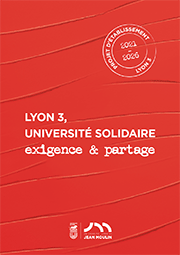AccueilRechercheProgrammes et productions scientifiquesThèsesThèses soutenuesThèses soutenues - 2022
-
Partager cette page
- Recherche,
- Philosophie,
ACHEUK-YOUCEF Maïssa Imène
Géohistoire architecturale et urbaine de Constantine 1837-1962 : connaître un héritage bâti pour reconnaître un patrimoine
Publié le 9 juin 2022 – Mis à jour le 9 juin 2022
Thèse en cotutelle en Géographie-Aménagement, soutenue le 19 janvier 2022.
Constantine, possède un héritage architectural et urbain datant de la période 1837-1962, riche, dominant dans son paysage urbain mais encore très largement méconnu. La production d’une connaissance sur cet héritage constitue le premier pas vers sa reconnaissance et ainsi sa mise en valeur. Avant d’envisager son devenir, il importe d’abord de l’identifier, de le caractériser et de comprendre ses logiques de production en retraçant son histoire.
En particulier, la géohistoire urbaine et architecturale de cet héritage apporte une connaissance approfondie et une compréhension de comment, quand, où, pourquoi, et par qui, cet héritage de la ville dans son ensemble et à ses différentes échelles a été produit.
Pour ce faire, ce travail de recherche est basé sur une historicisation de l’espace bâti à ses différentes échelles urbaines et architecturales, impliquant l’identification, la documentation et la datation des objets de cet espace. Cela implique également l’étude systématique de son processus de production aux échelles de la ville, des quartiers, des lotissements, des sous-lotissements, des rues et enfin des architectures, à travers une approche géohistorique.
Ainsi pour connaître cette architecture produite, il s’agit alors d’appréhender l’espace urbain de Constantine dans son évolution historique, sociale et spatiale en identifiant, caractérisant et datant aux différentes échelles, les opérations d’urbanisme et l’architecture à l’échelle du bâti. Considérant que chaque nouvel objet dans l’espace nécessite la mobilisation de plusieurs acteurs, il apparaît nécessaire de mettre en évidence la complexité de ce jeu d’acteurs publics et privés : pouvoirs civil et militaire, société civile, architectes et bâtisseurs.
À l’échelle du bâti, il s’agit également de mettre en exergue la richesse et la diversité architecturale du patrimoine bâti et d’identifier les registres architecturaux de cet héritage.
Pour aboutir à ces objectifs, cette recherche croise en permanence la réalité matérielle du terrain d’étude, première source historique vivante à interroger, avec l’analyse de nombreuses sources historiques archivistiques inédites, graphiques et écrites (plans à différentes échelles, permis de construire, dossiers de rues, rapports, procès-verbaux, correspondances, etc.) résultant d’un important travail de dépouillement mené dans différentes archives dispersées entre l’Algérie et la France, représentant plus de 10 000 sources d’archives historiques de première main mobilisées.
Cette démarche inclut également la constitution d’un SIG historique pour le patrimoine architectural et urbain de Constantine (1837-1962), ce qui n’existe pas encore pour la ville, à partir de la capitalisation des données archivistiques. Les données sont spatialisées par le biais d’une cartographie historique et de leur géoréférencement. Ce travail a permis également de produire une analyse spatiale et une cartographie détaillée et rigoureuse des transformations de la ville, ainsi qu’une datation précise du bâti à ses différentes échelles entre 1837 et 1962. Cette base de données numérique pour la connaissance de cet héritage, à l’échelle du bâti et de la ville pourrait contribuer au développement d’un instrument de sensibilisation, d’aide à la décision, de protection et de valorisation de cet héritage architectural et urbain.
En particulier, la géohistoire urbaine et architecturale de cet héritage apporte une connaissance approfondie et une compréhension de comment, quand, où, pourquoi, et par qui, cet héritage de la ville dans son ensemble et à ses différentes échelles a été produit.
Pour ce faire, ce travail de recherche est basé sur une historicisation de l’espace bâti à ses différentes échelles urbaines et architecturales, impliquant l’identification, la documentation et la datation des objets de cet espace. Cela implique également l’étude systématique de son processus de production aux échelles de la ville, des quartiers, des lotissements, des sous-lotissements, des rues et enfin des architectures, à travers une approche géohistorique.
Ainsi pour connaître cette architecture produite, il s’agit alors d’appréhender l’espace urbain de Constantine dans son évolution historique, sociale et spatiale en identifiant, caractérisant et datant aux différentes échelles, les opérations d’urbanisme et l’architecture à l’échelle du bâti. Considérant que chaque nouvel objet dans l’espace nécessite la mobilisation de plusieurs acteurs, il apparaît nécessaire de mettre en évidence la complexité de ce jeu d’acteurs publics et privés : pouvoirs civil et militaire, société civile, architectes et bâtisseurs.
À l’échelle du bâti, il s’agit également de mettre en exergue la richesse et la diversité architecturale du patrimoine bâti et d’identifier les registres architecturaux de cet héritage.
Pour aboutir à ces objectifs, cette recherche croise en permanence la réalité matérielle du terrain d’étude, première source historique vivante à interroger, avec l’analyse de nombreuses sources historiques archivistiques inédites, graphiques et écrites (plans à différentes échelles, permis de construire, dossiers de rues, rapports, procès-verbaux, correspondances, etc.) résultant d’un important travail de dépouillement mené dans différentes archives dispersées entre l’Algérie et la France, représentant plus de 10 000 sources d’archives historiques de première main mobilisées.
Cette démarche inclut également la constitution d’un SIG historique pour le patrimoine architectural et urbain de Constantine (1837-1962), ce qui n’existe pas encore pour la ville, à partir de la capitalisation des données archivistiques. Les données sont spatialisées par le biais d’une cartographie historique et de leur géoréférencement. Ce travail a permis également de produire une analyse spatiale et une cartographie détaillée et rigoureuse des transformations de la ville, ainsi qu’une datation précise du bâti à ses différentes échelles entre 1837 et 1962. Cette base de données numérique pour la connaissance de cet héritage, à l’échelle du bâti et de la ville pourrait contribuer au développement d’un instrument de sensibilisation, d’aide à la décision, de protection et de valorisation de cet héritage architectural et urbain.
Mots-clés : Héritage architectural et urbain, géohistoire, histoire de l'architecture, période coloniale française, histoire urbaine, XIXe-XXe siècles, SIG-Historique (Système d'Information Géographie Historique), Constantine (Algérie).
Constantine has a rich architectural and urban heritage dating from the period 1837-1962, which is dominant in its urban landscape but is still largely unknown. The production of knowledge about this heritage is the first step towards its recognition and thus its enhancement. Before considering its future, it is important to identify and characterise it and to understand its production logic by tracing its history.
In particular, the urban and architectural geohistory of this heritage provides an in-depth knowledge and understanding of how, when, where, why, and by whom this heritage of the city as a whole and at its different scales was produced.
To do this, this research work is based on a historicisation of the built space at its different urban and architectural scales, involving the identification, documentation and dating of the objects in this space. This also implies the systematic study of its production process at the scales of the city, the districts, the allotments, the sub-allotments, the streets and finally the architectures, through a geohistorical approach.
In order to understand this produced architecture, it is necessary to understand the urban space of Constantine in its historical, social and spatial evolution by identifying, characterising and dating at different scales, the urban planning operations and the architecture at the building scale. Considering that each new object in space requires the mobilisation of several stakeholders, it appears necessary to highlight the complexity of this game of public and private stakeholders: civil and military authorities, civil society, architects and builders.
At the scale of the built environment, it is also necessary to highlight the architectural richness and diversity of the built heritage and to identify the architectural registers of this heritage.
To achieve these objectives, this research constantly crosses the material reality of the study area, the first living historical source to be questioned, with the analysis of numerous unpublished historical archival sources, both graphic and written (plans at different scales, building permits, street files, reports, minutes, correspondence, etc.) resulting from an important work of analysis carried out in different archives scattered between Algeria and France, representing more than 10,000 first-hand historical archive sources mobilised.
This approach also includes the constitution of a historical GIS for the architectural and urban heritage of Constantine (1837-1962), which does not yet exist for the city, based on the capitalisation of archival data. The data is spatialised by means of historical mapping and geo-referencing. This work has also made it possible to produce a spatial analysis and a detailed and rigorous cartography of the city's transformations, as well as a precise dating of the buildings at its different scales between 1837 and 1962. This digital database for the knowledge of this heritage, at the scale of the building and the city, could contribute to the development of an instrument for awareness-raising, decision-making, protection and enhancement of this architectural and urban heritage.
Keywords : Architectural and Urban Heritage, Geohistory, Architectural History, French Colonial Period, Urban History, XIXth-XXth centuries, Historical-GIS (Historical Geographic Information System), Constantine (Algeria).
Directeur et directrice de thèse : Bernard GAUTHIEZ et Badia BELABED-SAHRAOUI
Membres du jury :
- Mr GAUTHIEZ Bernard, Directeur de thèse, Professeur des universités, Université Jean Moulin Lyon 3, France
- Mme BELABED-SAHRAOUI Badia, Co-directrice de thèse, Professeure des universités, Université de Constantine 3, Algérie,
- Mme SENHADJI Dalila, Rapporteure, Maître de conférence HDR, Université USTO Oran, Algérie,
- Mr VARAGNOLI Claudio, Rapporteur, Professeur des universités, Università di Chieti Pescara, Rome, Italie,
- Mr ANDRIEUX Jean-Yves, Professeur des universités émérite, Université Paris-Sorbonne, France,
- Mme BENSAÂD REDJEL Nadia, Maître de conférence HDR, Université d’Annaba, Algérie.
- Mme BELABED-SAHRAOUI Badia, Co-directrice de thèse, Professeure des universités, Université de Constantine 3, Algérie,
- Mme SENHADJI Dalila, Rapporteure, Maître de conférence HDR, Université USTO Oran, Algérie,
- Mr VARAGNOLI Claudio, Rapporteur, Professeur des universités, Università di Chieti Pescara, Rome, Italie,
- Mr ANDRIEUX Jean-Yves, Professeur des universités émérite, Université Paris-Sorbonne, France,
- Mme BENSAÂD REDJEL Nadia, Maître de conférence HDR, Université d’Annaba, Algérie.
Présidente du jury : Jean-Yves ANDRIEUX
Documentation
Mise à jour : 9 juin 2022







